Although human understanding of aviation has advanced far beyond what the Wright brothers initially envisioned, the fear of falling from the sky has never diminished – the fear of plummeting from the sky to the ground.
To illustrate, think about running out of gas while driving. As long as the car is on the ground, it will eventually reach a gas station.
But what happens if an airplane runs out of fuel mid-flight? Is falling from the sky unavoidable?

In-Flight Refueling through “Air Gas Stations”
It turns out that the more brilliant minds among us anticipated such problems. The risk of an airplane running out of fuel on long-haul flights is very real. Therefore, airplanes are refueled mid-flight by larger aircraft.
This process is commonly referred to as in-flight refueling. However, mid-air refueling is not a standard method and is only used as a contingency in critical operations.
When Do Airplanes Run Out of Fuel Mid-Flight?
An aircraft’s engines may not receive fuel for two reasons. The first is fuel starvation, where fuel is present in the plane but cannot reach the engine due to a transmission fault. Fuel starvation can only be remedied through maintenance.
On the other hand, fuel exhaustion means there is no fuel left at all. Reasons for fuel exhaustion may include, but are not limited to:
- Long-distance missions
- Miscalculating or underestimating the necessary fuel
- Loss of distance due to air currents at lower altitudes
Fuel exhaustion typically occurs at the end of a certain journey and can be remedied by refueling.
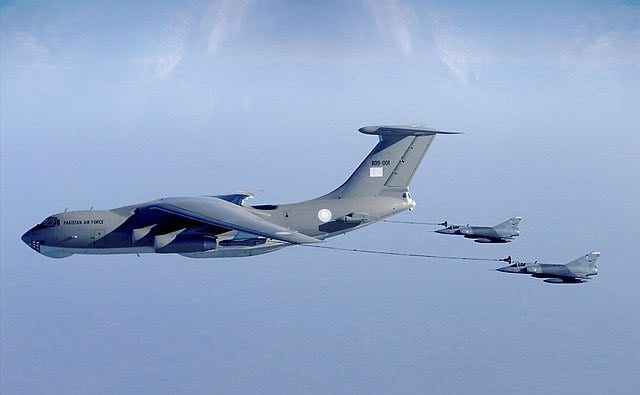
Fuel tankers are air gas stations capable of refueling one or more aircraft during a mission.
Which Aircraft Can Be Refueled in Flight?
Aircraft are typically designed for refueling on the ground. For in-flight refueling, the fuel ports of the aircraft must be relocated to accessible positions to allow connection with the refueling hoses. Therefore, any aircraft can be refueled mid-air, as long as they are modified accordingly.
However, unlike road vehicles, the cost of in-flight refueling is very expensive. When combined with safety issues arising from two aircraft flying in such close proximity, both tangible and intangible costs can quickly escalate. Thus, in-flight refueling is primarily limited to military operations.
Notable exceptions to this rule are aircraft of strategic importance, such as presidential aircraft. Most presidential aircraft are commercial planes modified to be capable of in-flight refueling due to their national significance.

Air Force One, the aircraft of the President of the United States, is a modified Boeing 747 capable of in-flight refueling.
How Does In-Flight Refueling Work?
Theoretically, in-flight refueling is a relatively simple operation. Fuel is supplied by a “tanker aircraft” to a “receiving aircraft” while in flight. The receiving aircraft must have some fuel left as it needs to maintain flight until refueled.
The tanker aircraft flies and connects with the receiving aircraft using a rigid or flexible hose, then pumps fuel. This hose connects to a receptacle or probe on the receiving aircraft. To support the fuel flow, the receiving aircraft flies behind and below the tanker aircraft. The refueling speed depends on the refueling system and the size of the receiving aircraft.
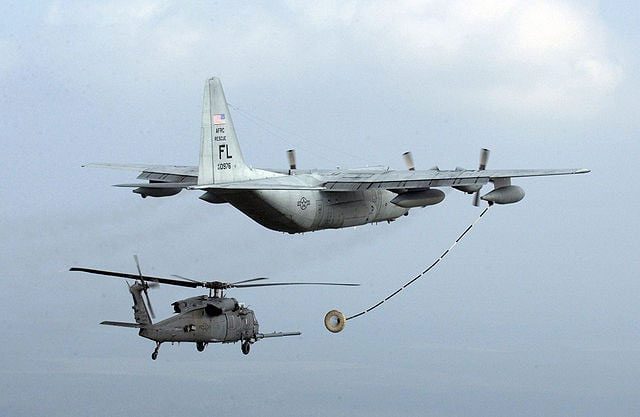
A fuel tanker drops a hose through which fuel is pumped into the receiving aircraft.

The receiving aircraft is equipped with receptacles (illuminated in orange – left photo) or probes (near the cockpit – right photo) to pump fuel into their tanks.
Globally, in-flight refueling operations are conducted using one of two systems:
Flying Boom System
The flying boom is a rigid, retractable tube extending from the rear of the tanker aircraft. It is deployed by an operator seated on the tanker aircraft.
When the receiving aircraft is within “refueling distance,” the flying boom is inserted into the receptacle, allowing the pumping of fuel to commence. The flying boom has high drag due to its aerodynamic configuration and rigidity. Therefore, it is equipped with small wings to stabilize it during the refueling process.
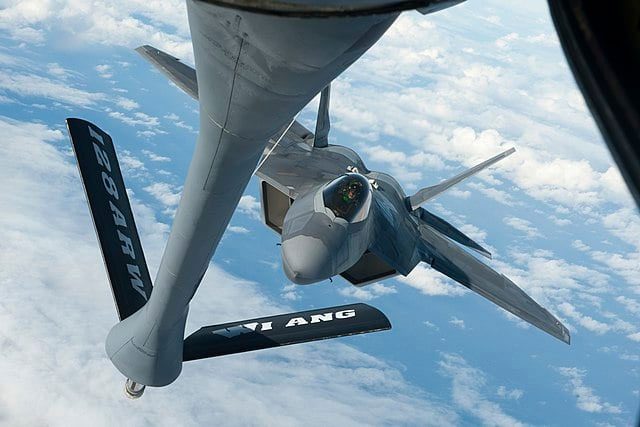
The flying boom is stabilized by small wing-like control surfaces during in-flight refueling.
The flying boom can pump up to 1,000 gallons per minute. Therefore, it is best used to refuel large military aircraft with high-capacity tanks.
The tanker aircraft typically has one flying boom that can serve only one aircraft at a time.
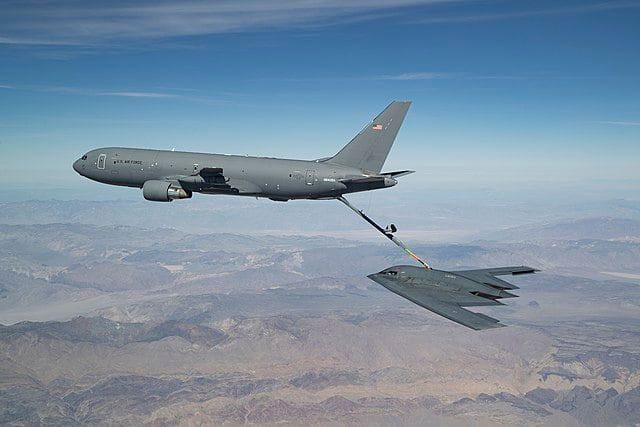
The flying boom is used to refuel larger aircraft, such as the B-2 stealth bomber, as shown above. However, the flying boom can only refuel one aircraft at a time.
Flexible Hose and Drogue System
Some tanker aircraft use flexible hoses instead of a rigid flying boom. They can also carry fuel in multiple storage compartments on one aircraft. This allows them to refuel multiple aircraft in one mission. Since the flexible hoses sway when released from a flying aircraft, they must be stabilized before refueling.
This is achieved by attaching a retractable device that creates drag known as drogues. Drogues are designed to increase the resistance of the hose, thereby preventing it from flailing.

The receiving aircraft in such refueling systems is equipped with probes, which are fixed or retractable tubes that can be extended and retracted from the aircraft’s fuselage. These tubes are rigid and connect to the hose, forming a link to transmit fuel. The probe and drogue system can refuel up to 600 gallons of fuel per minute and are therefore preferred for smaller aircraft.
Risks of In-Flight Refueling
In addition to the inherent dangers of two aircraft flying close together, there are several other risks associated with in-flight refueling. Internal risks include failures of the refueling system, such as releasing and retracting flexible hoses, fuel pumps, etc.
External risks arise from the potential for fuel spills, damage to refueling hardware during connection or disconnection, and improper alignment of the aircraft. Spatial disorientation, especially during night flights, also poses significant risks during in-flight refueling.
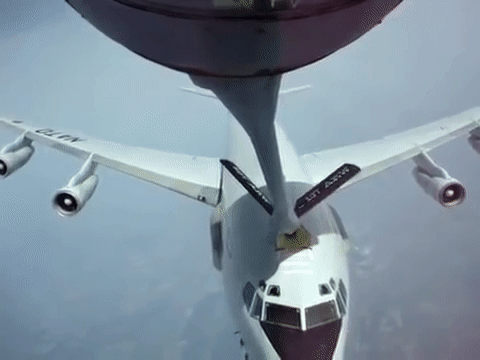
An impending collision with the fuel tanker forces the receiving aircraft to take evasive action.
Safety Protocols to Mitigate Risks
The proximity of a tanker aircraft to a receiving aircraft is unavoidable. Therefore, safety procedures and contingency safety mechanisms are implemented to enhance situational awareness and minimize accidents during refueling.
Tanker aircraft utilize external lighting systems that can adjust brightness to prevent the receiving aircraft from losing orientation and becoming dazzled, especially at night. Autopilot features are particularly useful for tracking the relative speed of both aircraft.
After refueling, the hose is retracted in a manner that prevents excess fuel from spilling onto the surface of the receiving aircraft.
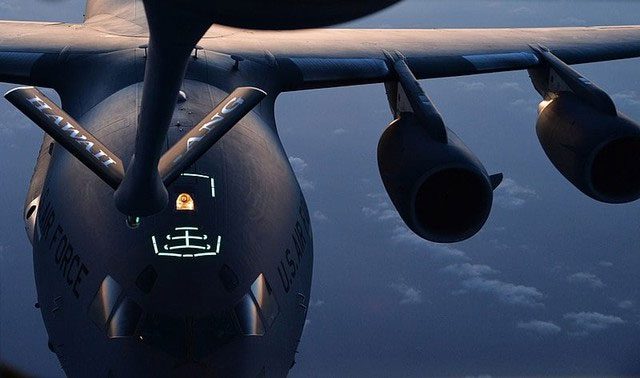
Proper lighting in low-light conditions is an essential part of safe in-flight refueling protocols.





















































